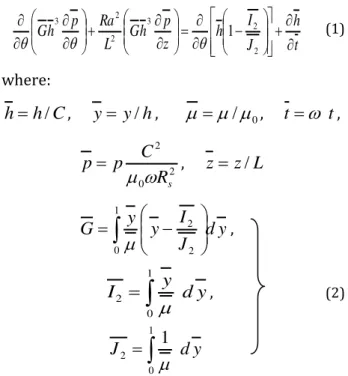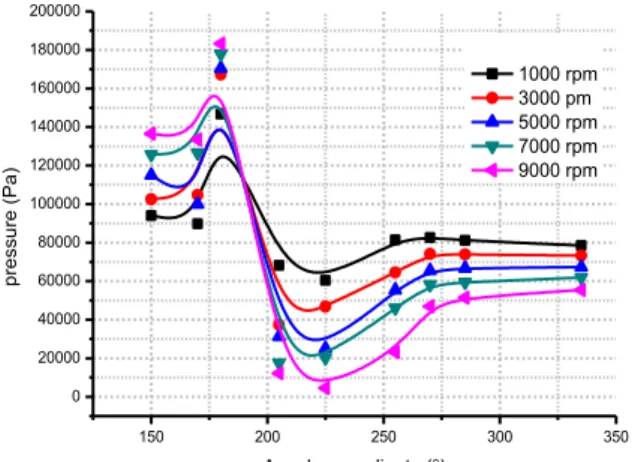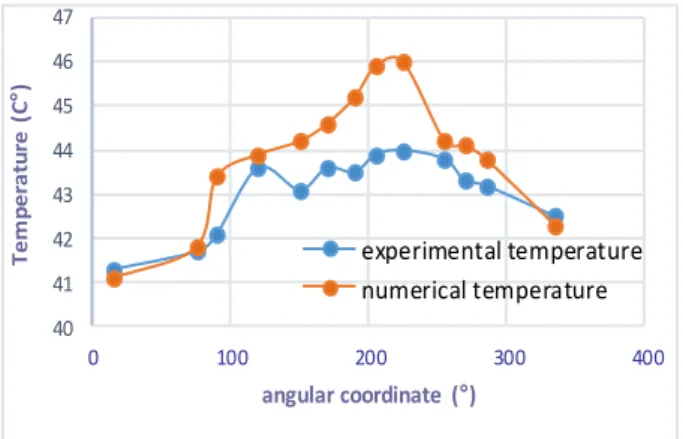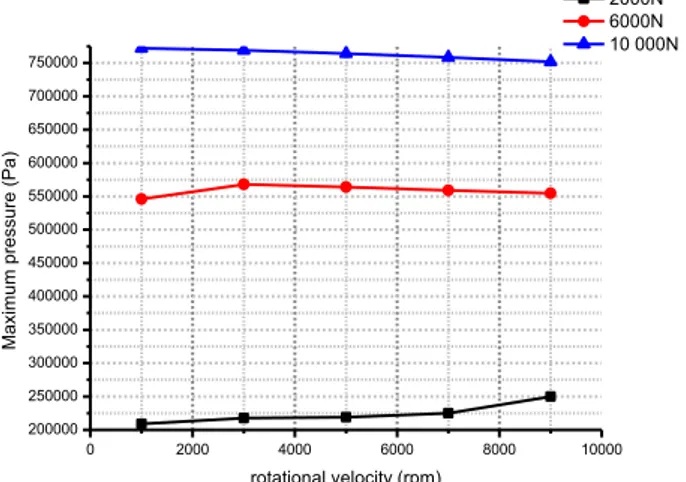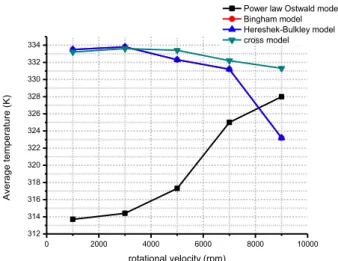Tribology in Industry
www.tribology.fink.rs
Numerical Analyses of the Non-Newtonian Flow
Performance and Thermal Effect on a Bearing
Coated with a High Tin Content
K. Mehala
a, N. Bendaoud
a, A. Youcefi
aaUniversity of the Sciences and Technology of Oran Mohammed Boudiaf, 1505 El Menaour Bir El Djir Oran Algeria
Faculty of mechanical engineering, Engineering department, Algeria.
Keywords:
Thermal effect Non-Newtonian flow
Plain cylindrical journal bearing Coated
A B S T R A C T
The hydrodynamic bearings are stressed by severe workings conditions, such as speed, load, and the oil will be increasingly solicit by pressure and shear. The Newtonian behavior is far from being awarded in this case, the most loaded bearings operating at very high speeds; the shear rate of the oil is of higher order.
A numerical analysis of the behavior of non-Newtonian fluid for plain cylindrical journal bearing finite dimension coated with antifriction material with a high tin content, for to facilitate the accommodation of the surfaces and save the silk of the shaft in the case of a contact. this analyses is implemented using the code-ANSYS CFX, by solving the energy equation with the finite difference method, considering that laminar regime and the fluid is non Newtonian by using the power law Ostwald model, the coefficient n is equal to 1.25 and for different model such as Bingham, cross and Hereshek-Bulkley model.
This study aims to better predict the non-Newtonian behavior of the oil film in bearings operating under more severe conditions. The purpose conducted during this study is to predict the effect of non-Newtonian behavior of the film; the journal bearing operating under severe conditions, the speed of rotation varies from 1000 to 9000 rpm and the bearing working under radial load 2 to 10 kN. Temperature and the pressure within the fluid film assumed non-Newtonian are high, with a coefficient n greater than 1 that is to say for viscoelastic fluids.
© 6 Published by Faculty of Engineering Corresponding author:
Kadda Mehala
University of the Sciences and Technology of Oran Mohammed Boudiaf, 1505 El Menaour Bir El Djir Oran Algeria
Faculty of mechanical engineering, Engineering department
E-mail: postegraduation@yahoo.com
1. INTRODUCTION
The non-Newtonian effects can be of two kinds: the shear-thinning effects and viscoelastic effects. The shear-thinning effects, often simply called non-Newtonian effects, result in a variation of the
viscosity versus shear rate. The viscoelastic effects are more complex, but in simple terms, we can say that the viscoelastic fluids have a memory of their deformities. There are several models that can represent the viscoelastic behavior. Among them, the simplest and most used is the Maxwell model,
R
E
S
E
A
R
C
which takes into account two parameters: viscosity and relaxation time.
The plain journal bearing have been largely used in industrial applications for more than a century. However, the thermal behaviour in the journal bearing became only recently the object for the researchers, while considering the fluid has a non-Newtonian behaviour.
Hirst and Moore [1] present a study in 1974 on
non-Newtonian behavior in the
elastohydrodynamic lubrication, they stated in their study that low values, the shear rate is directly proportional to the shearing force, but higher values, the shear rate increases faster than the shear stress, this phenomenon depends on the pressure and molecular size of the fluid film.
In 1985, Hutton [2] performs an experimental study on the effect of lubricant on the u performance sliding bearing, the experimental results performed on a bearing in order to verify the theory that the capacity of the load is generated by the elasticity viscoelastic lubricants.
Gecim [3] published in 1990 a review of the literature on shear-thinning effects. He shows some examples and technical solutions for the treatment of non-Newtonian effects in plain bearings. He introduced a new incorporating act, based on the Cross of law. The advantage of this law is that it has a single parameter to adjust (the stability coefficient), compared to the Cross equation which uses three parameters.
During the same period, Rastogi and Gupta [4,5] analyze the importance of viscoelastic effects in bearings subjected to dynamic loads that they use the Maxwell model. They showed a decrease Load carrying capacity in the presence of a viscoelastic behavior.
Lemaitre and Berker [6] realized two years later a study on the modeling of non-Newtonian effects in plain bearings. They propose an extension of the cavitation Elrod algorithm for a non-Newtonian behavior of the fluid, using the finite volume method.
In 2000, Zhang and Cheng [7] propose a non-Newtonian thermohydrodynamic analysis in conditions of mixed lubrication. Both non-Newtonian effects (shear thinning and
viscoelastic) are included. They show that there is significant influence of the shear thinning effect on the minimum thickness on the power loss and leakage flow dynamic bearings. However, the viscoelastic effect has no significant influence on these parameters and can more or months influence the load capacity bearings, compared to operating conditions.
In 2001 and 2002 Wang et al. [8,9] have also addressed the influence of shear thinning effects in dynamic bearings, while taking into account the non-Newtonian behavior and the effect of the geometry of the elliptical -form palier- ave rough surfaces. They show that it has a significant reduction in the minimum film thickness and power dissipation.
In the same year, Zhang [10] continues the study with an analysis TEHD dynamic bearings. It happens almost the same conclusions as in the THD study. Moreover, he argues that the viscoelastic effect tends to reduce the variation of pressure over time and thus reduce the pressure peaks and the elastic deformation.
In 2003 Kane [11] show the effect of the roughness and non-Newtonian effects in severe contact lubricated such as bearings. He presented a new modified Reynolds equation called non-Newtonian, using the rheological laws and the basics of continuum mechanics applied to thin film. Solving this equation gives the influential parameters on geometry and rheology, these results were validated with the non-Newtonian theory.
Fatu [12] in 2005 present a numerical and experimental modeling of the lubrication of motor bearings subjected to severe operating conditions with the laws of variation of the suitable viscosity, it stinks meter highlight the respective influence of non-effects Newtonian and piezovisqueux in the complex case of big end bearings. Fatu showed that piezovisqueux effect turns out to be most significant effect on the behavior of the bearing, the non-Newtonian effect.
calculated numerically for various values of viscosity index, have been significant with the non-Newtonian behavior of the fluid.
Javorova and his colaborators, have been presented in 2016 [14], a study on hydrodynamics Journal Bearings Considering Elastic Deformation and Non-Newtonian fluid, by using the Rabinowitsch fluid model. They have showed that higher values of film pressure and load carrying capacity have been obtained for dilatant lubricants, while for pseudoplastic lubricants; pressure in oil film is less significant.
The present study investigates the effect of temperature in laminar regime by resolution of the energy equation with the finite difference method. This analysis studied the impact the behavior non-Newtonian fluid for journal bearing working under sever operating condition. The non-Newtonian behavior of lubricants (oils containing polymers PM3) was analyzed numerically. Moreover, the fact that the oils containing polymers should have a decrease in viscosity and normal stress at a high shear rate, so having a non-Newtonian behavior, rheological properties were examined according to the levels of operating conditions by Moritsugu KASAI in 2010 [15].
2. THEORETICAL ANALYSES
In order to theoretically predict the temperature field throughout a plain bearing, one ought to create a 3D thermohydrodynamic theoretical model. The schematic representation of the journal bearing is presented in Fig. 1.
OS OB R S RB
e
W X YFig. 1. Schematisation of plain journal bearing.
2.1 Basic Equations
The equation describing the flow in the gap is the generalized Reynolds equation (Dowson, [16]).
t h J I h z p h G L Ra p h G 2 2 3 2 2 3 1
(1)
where:
C
h
h
/
, y y/h,
/
0,t
t
,2 0 2 s R C p p
,
z
z
/
L
dy J I y y
G
1 0 2 2
,
I
y
d
y
1
0 2
, (2)
J
d
y
1
0 2
1
In order to get pressure field, Reynolds type boundary conditions are considered. The boundary conditions for pressure are summarized by the following equations:
- at the bearing sides:
,
L
/
2
0
p
(3)- At the limit of the rupture zone traditional Reynolds boundary conditions are applied:
0
r rp
p
(4)The temperature in the bush is given by the bidimensional energy equation in polar coordinates:
2 2 21
1
T
r
r
T
r
r
r
k
t
T
c
B BB (5)
The temperature in the shaft is supposed to be uniform in the circumferential direction, due to its rotation; the energy equation reduces to a unidimensional form: r T r r r k t T
cs s
s
1
Heat flux continuity condition was imposed at the interface between the oil film and the shaft:
o
I
y F Rs r
s d
y T k r
T k
0
2 (7)
While at the interface between the oil film and the bush the heat flux continuity condition is:
B
R r B
h y B
r T k y
T
k
(8)
The initial temperature condition for the transient problem is:
0
0 T
T
t
2.2 Empirical relationships for viscosity
When the viscosity is not independent of shear rate, it is necessary to use several parameters to describe the mechanical behavior of the fluid. A number of empirical models provide this description.
2.2.1 Pseudo plastic Fluids
Fluid conducting a pseudo-plastic viscosity decreases when the shear stress increases, their rheological behavior are not linear these are monophasic oils such as heavy oils.
a) Model of power law Ostwald: In a certain range of shear rates, the viscosity can be
represented as a power law,
particularly formolten polymers:
1 0
n
(1)Newtonian fluid corresponds to n = 1 and a shear-thinning fluid is represented by n <1.
The model of the power law can be used for fluids such as rubber, adhesive, polymers or certain body fluids for isothermal flow. In the case where the temperature varies in the field, it is possible to introduce the temperature T:
eT n
e
1
0
(2)b) Carreau model: The tile model is an extension of thepower lawmodel that involves five parameters:
a n a 1/
0
] ) ( 1
[
(3)
where
0 is the zero shear viscosity,
viscosity at infinite shear, time constant,
is an exponent of power law and is a parameter that describes the transition from the low shear and power law behavior region.2.2.2 Viscoplastic oils
The nonlinear viscoplastic oil are characterized by a shear threshold it has two phases: liquid and solid as example fats. In this section we present the fluids and Bingham Hereshek-Bulkley.
a) Bingham model
The Bingham fluid viscoplastic are characterized by a single elastic ι0, over which the said fluids behave as Newtonian fluids. The viscosity is is expressed by:
0 0
(4)where µ0 reference viscisity.
b) Hereshek-Bulkley model
The model Hereshek-Bulkley presents the nonlinear case from that of Bingham, this model is a combination of yield strength and plastic nickname behavior of the power law, this law is presented in the following form:
01 n
K
(5)
2.2.3 Expression of the pressure field with non-Newtonian behavior oil film
Eg the power model Ostwald, the relationship of the pressure field is given in the following form:
4 ² ² sin )
( 6
3 1 0 )
, (
L Z h
C p
r n
z
(6)
2.3 Thermal Deformations
Rs
s s
s
T
r
t
T
rdr
R
t
u
0
0
)
,
(
2
)
(
(9)The thermal displacement of the bush
u
B(
)
is computed using the Finite element method.2.4 Film thickness
Due to the thermal deformations of both the shaft and the bush, the film thickness is given by the following expression:
C
1
cos(
)
(
)
h
(10)with:
s
B u
u
( )
)
(
(11)3. NUMERICAL RESOLUTION ON THE THERMOOHYDRODYNAMIC EFFECT OF THE BEARING ON TRANSIENT REGIME
In this part, we present the transient analysis on speed effect for plain journal bearing and for thermohydrodynamic behaviour in lubricated mechanism.
This study is carried out by the ANSYS CFX code for obtain the pressure field distribution with energise equation resolution, by using the Finite Differential Method. The both shaft and bush deformation is obtained with displacement equation resolution by Finite Elements Method. The discretization of the geometry in a number of elements finished well is presented in Fig. 2. In this meshing, nodes number is 31200 and element number is 244201.
Fig. 2. Finite element mesh of the bearing.
3.1 Results and Discussed
The main features of the bush are presented in Table 1.
Table 1. Operating conditions and geometric characteristics of the journal bearing.
Bearing diameter Bearing lemgth Radial clearance Length of supply groove Food opening diameter Lubricant type
Density of oil
Specific heat of lubricant Oil viscosity at ºC Oil viscosity at ºC Rotational speed Radial load
Ambient temperature Supply pressure
D (mm) 100 L (mm) 80 C (mm) 0.09 Lg (mm) 70 do (mm) 14 PM3
(kg/m3) 800
Cp (j/kgK) 2000
1 mmª/s ,
2 mmª/s ,
N (r/min) 1000-9000 W (kN) 2-10
Ta ºC 60 Pa (MPa) 0.04
Pressure/Temperature
1) Velocity variation for load 2000 N and n=1.25
Pressure
1000 rpm 3000 rpm 5000 rpm
7000 rpm 9000rpm
Maximum pressure according rotational velocity for radial load 2000 N and for power law Ostwald model, the coefficiet n is equal to 1.25, Is preseted in Fig. 4a. Import values for pressure is noted for higly velocity (9000 rpm). Increses is estimated of 90 per cent for velocity ranging of 1000 to 9000 rpm.
0 2000 4000 6000 8000 10000 80000
100000 120000 140000 160000 180000 200000
ma
xi
mu
m
p
re
ssu
re
(Pa
)
Rotational velocity (rpm)
radial load 2000N and n = 1,25
Fig. 4a. Maximum pressure according rotational velocity for radial load 2000 N and n=1.25 Model of power law Ostwald.
150 200 250 300 350
0 20000 40000 60000 80000 100000 120000 140000 160000 180000 200000
p
re
ssu
re
(Pa
)
Angular coordinate (°)
1000 rpm 3000 pm 5000 rpm 7000 rpm 9000 rpm n = 1,25 W= 2000N
Fig. 4b. Circumferentiel pressure for different rotational velocity and for radial load 2000 N and
n=1.25 (Model of power law Ostwald).
Pressure distribution of the median plain cylindrical journal bearing for rotational velocity 1000 to 9000 rpm and for radial load 2000 N, is illustrates in Fig. 4b, for power law Ostwald model with n = 1.25.
The maximum pressure increases up to 180000 Pa for rotational speed ranging from 1000-9000 rpm, the increase is estimated by 76 per cent. It is situated at angular coordinate ° and °.
There is the creation of the rupture zone of highly significant oil film, for Angular coordinate ° to ° for a bearing operating under velocity of 9000 rpm and for radial load 2000 N. The pressure drop reaches 0.08 MPa.
Figure 5 show the pressure distribution of the median plain cylindrical journal bearing for radial load 2000, 6000 and 10000 N and for rotational velocity 9000 rpm, for power law Ostwald model with n = 1.25.
0 50 100 150 200 250 300 350 -300000
-250000 -200000 -150000 -100000 -50000 0 50000 100000 150000 200000 250000 300000 350000 400000 450000 500000 550000 600000 650000
Pre
ssu
re
(Pa
)
Angular coordinate (°)
2000 N 6000N 10 000N n = 1,25 N = 9000rpm
Fig. 5. Circumferentiel pressure for different radial load for velociy 9000 rpm and n=1.25 (Model of power law Ostwald).
The significate pressure values is noted for radial load of 10000 N, and the rupture zone is highly significant for radial load 10000 N.
Temperature
Temperature evolution in medi n plain journal bearing for velocity ranging of 1000 to 9000 rpm is presented in Fig. 6. This figure shows clearly that sigignificat temperature is obtain for velocity 7000 and 9000 rpm, for bearing subjected to radial load 2000 N and lubricat by non newtonein fluid with coefficient n equal to 1.25.
1000 rpm 3000 rpm 5000 rpm
7000 rpm 9000 rpm
The Average temperature according rotational velocity for radial load 2000 N and n=1.25 (Model of power law Ostwald), is shown in Fig. 7a, obtained from the numerical analysis in 6000, 9000, 11 000, 13 000 and 15 000 rpm and a radial load of 2000 N. The feeding condition is presented in the Table 1. An increase of temperature is estimated of 4 per cent with increases the velocity from 1000 to 9000 rpm.
0 2000 4000 6000 8000 10000 312
314 316 318 320 322 324 326 328
Ave
ra
g
e
t
e
mp
e
ra
tu
re
Roational velocity (rpm)
Radial load 2000 n and n= 1,25
Fig. 7a. Average temperature according rotational velocity for radial load 2000 N and n=1.25 (Model of power law Ostwald).
0 50 100 150 200 250 300 350 310
315 320 325 330 335
T
e
mp
e
ra
tu
re
(K)
Angular coordinate (°)
1000 rpm 3000 pm 5000 rpm 7000 rpm 9000 rpm n = 1,25 W = 2000N
Fig. 7b. Average temperature for different rotational velocity for radial load 2000 N and n=1.25 (Model of power law Ostwald).
However, the Fig. 7b illustrates the distribution of the average temperature in median plan for journal bearing. Rotational velocity is ranging of 1000 to 9000 rpm. The bearing is subjected to radial load of 2000 N and fluid low is considered non-Newtonian fluid. This figure shows clearly that the significant temperature is located for angular coordinate ° to °. The import values are noted for velocity of 9000 rpm.
Figure 8 presents the circumferentiel distribution of temperature for different radial load (2000, 6000 and 10 000N) and for rotational velocity 9000 rpm, n=1.25 (power law Ostwald model). The maximum values for temperature is noted for low radial load (2000 N).
0 50 100 150 200 250 300 350 310
315 320 325 330 335
T
e
mp
e
ra
tu
re
(K)
Angular coordinate (°)
2000 N 6000 N 10 000N n = 1,25 N = 9000 rpm
Fig. 8. Circumferentiel temperature for different radial load and for rotational velocity 9000 rpm
n=1.25 (Modelof power law Ostwald).
These digital temperature results were validated with experimental results; that were presented by the Bendaoud and al in 2012 [17] while considering the fluid is Newtonian, Fig. 9.
Figure 9 present circemfereciel temperature ditribution for radial load 2000 N and rotational velocity 5000 rpm for experiment data and Numerical resul for fluid newtonian. The Search result is a reasonable agreement, the gap is estimated 6 per cent.
40 41 42 43 44 45 46 47
0 100 200 300 400
T
em
p
er
a
tu
re
(C
°
)
angular coordinate (°)
experimental temperature numerical temperature
2) Pressure and temperature for different (n) for load 2000N and velocity 1000 rpm
Maximum pressure for different n for power law Ostwald model is presented in figure 10, for radial load of 2000N and rotational speed 1000 rpm. The maximum value for pressure is obtain for n equal to 1.5 and is estimates by 250000 Pa. Pressure increase with increases of the coefficient n, this increase’s is estimated by per cent.
0,2 0,4 0,6 0,8 1,0 1,2 1,4 1,6
80000 100000 120000 140000 160000 180000 200000 220000 240000 260000 280000
ma
xi
mu
m
p
re
ssu
re
(Pa
)
Rotational velocity (rpm)
Radial load 2000 N veleocity 1000 rpm
Fig. 10. Maximum pressure for different n (Model of power law Ostwald).
For the variation of the average temperature (Fig. 11), Temperature is significate for coefficient n equal to 1.5.
0,2 0,4 0,6 0,8 1,0 1,2 1,4 1,6 313,2
313,3 313,4 313,5 313,6 313,7 313,8 313,9 314,0 314,1
Ave
ra
g
e
t
e
mp
e
ra
tu
re
(K)
n
radial load 2000 n velocity 1000 rpm
Fig. 11. Average temperature for different n (Model
of power law Ostwald).
Figure 12 presents the variation of the friction coefficient according rotational speed 1000 to 9000 rpm and for radial loads of 2000 N, this variation is carried out by power law Ostwald with n = 1.25. Friction coefficient has an increase (0.005-0.064), is estimated of 80 per cent.
Maximum value obtains for velocity of 9000 rpm is 0.064; this value is between 0.05 and 0.2 (limit lubrication).
0 2000 4000 6000 8000 10000
0,00 0,01 0,02 0,03 0,04 0,05 0,06 0,07
F
ri
ct
io
n
co
e
ff
ici
e
n
t
rotational velocity (rpm)
2000N
Fig. 12. Friction coefficient according rotational velocity for n=1.25 (Model of power law Ostwald).
Figure 13 presents the variation of the maximum pressure with velocity variation of 1000 to 9000 rpm, for tree different radial load (2000, 6000 and 10000 N), the fluid is considered non-Newtonian with n=1.25. Important values are obtained for radial loads 10000 kN.
0 2000 4000 6000 8000 10000
200000 250000 300000 350000 400000 450000 500000 550000 600000 650000 700000 750000
Ma
xi
mu
m
p
re
ssu
re
(Pa
)
rotational velocity (rpm)
2000N 6000N 10 000N
Fig. 13. Maximum pressure variation according rotational velocity for different radial load (Model of power law Ostwald).
0 2000 4000 6000 8000 10000 312
314 316 318 320 322 324 326 328 330
Ave
ra
g
e
t
e
mp
e
ra
tu
re
(K)
rotational velocity (rpm)
2000N 6000N 10 000N
Fig. 14. Average temperature according velocity for different radial load (Model of power law Ostwald).
Figures 15 and 16 illustrates respectively the maximum pressure and average temperature variation according rotational velocity for different non-Newtonian model and for radial load of 2000 N.
0 2000 4000 6000 8000 10000
0 2000000 4000000 6000000 8000000 10000000 12000000 14000000
Ma
xi
mu
m
p
re
ssu
re
(Pa
)
Rotational velocity (rpm) Power law Ostwald model Bingham model Hereshek-Bulkley model Cross model
Fig. 15. Maximum pressure variation according rotational velocity for different model and load 2000 N.
0 2000 4000 6000 8000 10000
312 314 316 318 320 322 324 326 328 330 332 334
Ave
ra
g
e
t
e
mp
e
ra
tu
re
(K)
rotational velocity (rpm)
Power law Ostwald model Bingham model Hereshek-Bulkley model cross model
Fig. 16. Average temperature according velocity for different model and for load 2000 N.
The power law Ostwald model gives a realistic temperature variation unlike the other model. Knowing that the temperature increases with increasing the rotation speed of the bearing.
4. CONCLUSION
Most oils are considered to have a linear variation in the shear stress versus shear rate, for some highly additive oils and which operate under severe stress; the behavior is no longer Newtonian. One speaks in this case, a non-Newtonian behavior.
To represent these behaviors, we expose a numerical study on the behavior of non-Newtonian fluid with several rheological models such as the simplest model of Oswald (also known as the power law), Bingham, cross and Hereshek-Bulkley model. The thermal effect has been included on the behavior of the bearing to obtain the temperature map. The bearing alloy coated with an anti-friction high tin content (Babbitt 88 % Tin).
Temperature is high and reaches a maximum value of 328 K, a bearing for operating at a speed of 9000 rpm and which is subjected to a radial load of 2000 N. The temperature increases 15 K.
However, the maximum pressure reached a value of 0.18MPa and it is noted in the angular position of the bearing of from ° to ° by varying the rotation speed of bearing of 1000 rpm to 9000.
Temperature and the pressure within the fluid film assumed non-Newtonian are high, with a coefficient n greater than 1 that is to say for viscoelastic fluids.
REFERENCES
[1] W. Hirst and A.J. Moore; Non-Newtonian
Behaviour in Elastohydrodynamic Lubrication ,
Proceedings of the Royal Society of London. Series A, Mathematical and Physical Sciences, vol. 37, pp. 101-121, 1974.
[2] J.F. Hutton, K.P. Jackson and B.P. Williamson,
The effects of lubricant rheology on the
performance of journal bearings , ASLE
[3] B.A. Gecim, "Non-Newtonian Effects of Multigrade Oils on Journal Bearing Performance", STLE Tribology Transaction, vol. 33, pp. 384-394, 1990.
[4] A. Rastogi and R.K. Gupta, "Lubricant Elasticity and the Performance of Dynamically Loaded Short Journal Bearings", Journal of Rheology, vol. 34, no. 8, pp. 1337-1356, 1990.
[5] A. Rastogi and R.K. Gupta, "Accounting for Lubricant Shear Thinning in the Design of Short Journal Bearings", Journal of Rheology, vol. 35, no. 4, pp.589-603, 1991.
[6] F. Lemaître and A. Berker, "Non-Newtonian Cavitation Analysis in Journal Bearings", Elsevier Journal of Non-Newtonian Fluid Mechanics, vol. 59, pp. 31-48, 1995.
[7] C. Zhang, "Thermoelastohydrodynamic of non-newtonian dynamically loaded journal bearing in mixed lubrication direct problem", ASME Jounal of Tribology, vol. 124, pp. 178-185, 2002. [8] P. Wang, T.G. Keith and K. Vaidyanathan,
"Non-Newtonian Effects on the Performance of Dynamically Loaded Elliptical Journal Bearings Using a Mass-Conserving Finite Element Cavitation Algorithm", STLE Tribology Transaction, vol. 44, no. 4, pp. 533-542, 2001. [9] P. Wang, T.G. Keith and K. Vaidyanathan,
"Combined Surface Roughness Pattern and Non-Newtonian Effects on the Performance of Dynamically Loaded Journal Bearings", STLE Tribology Transaction, vol. 45, no. 1, pp. 1-10, 2002. [10] C. Zhang, Y. Wang, Q. Wang and, C. Lin, "A mixed –
tehd analysis and experimantal of journal bearing under severe operating conditions", Tribology International, vol. 35, pp. 395-407, 2002.
[11] M. kane , "l’effet de la rugosité et des effets non
-newtoniens dans les contacts sévères lubrifiés",
Thèse de Doctorat, Institut national des sciences
appliquées de Lyon, 2003.
[12] A. Fatu, "Numerical and experimental modeling of the lubrication of motor bearings subjected to drying conditions", Doctoral thesis, doctoral school of sciences for the engineer of the University of Poitiers, 2005.
[13] U.P. Singh, R.S. Gupta and V.K. Kapur, “On the Performance of Pivoted Curved Slider Bearings: Rabinowitsch Fluid Model , Tribology in Industry, vol. 34, no. 3, pp. 128-137, 2012.
[14] J. Javorova, A. Mazdrakova, I. Andonov and A.
Radulescu, Analysis of (D Journal Bearings
Considering Elastic Deformation and
Non-Newtonian Rabinowitsch Fluid Model , Triboloby
in Industry, vol. 38, no. 2, pp. 186-196, 2016. [15] M. Kasai, "Reducing friction and improving the
reliability of the bearing lubrication with automotive engine oils". Thesis, University of Poitiers, specialty Mechanical Engineering, Industrial Engineering, Transportation, 2010.
[16] A. Dowson, A Generalised Reynolds Equation
for Fluid Film Lubrication Int. Jour. Mech. Sc.,
vol. 4 pp. 159-170, 1962.
[17] N. Bendaoud, K. Mehala, A. Youcefi and M. Fillon, An experimental and numerical investigation in elastohydrodynamic behaviour of a plain
cylindrical journal bearing heavily loaded Tribology- Proceedings of the Institution of
Mechanical Engineers, Part J: Journal of Engineering Tribology, vol. 226, no. 10, pp. 809-818, 2012.
[18] K. Mehala, N. Bendaoud and A. Youcefi,
Evolution of the lubrication regime of a
cylindrical journal bearing in the starting phase ,
Industrial Lubrication and Tribology, vol. 66, no. 3, pp. 379–386, 2014.
NOMENCLATURE
cs: specific heat [J/kg.k]
e: eccentricity [m] h: film thickness [m]
k: thermal conductivity[w/m.K] p: pressure [MPa]
t: time [s]
us:thermal deformation of the shaft [m]
uB:thermal deformation of the bush [m]
x, y: Cartesian coordinate, x = Rs
C: bearing clearance [m] L: bearing length [m] OB: bush center
Os: shaft center
Rs: shaft radius [m]
RB: bush radius [m] T: temperature [ºC]
T0: initial temperature [ºC]
